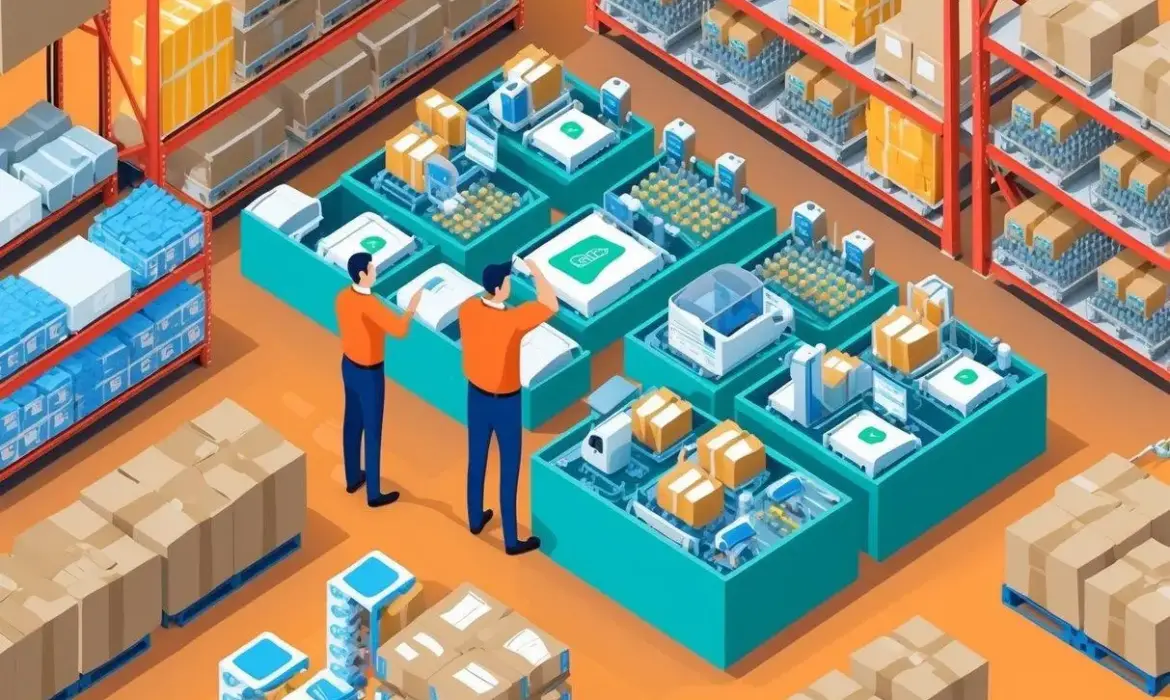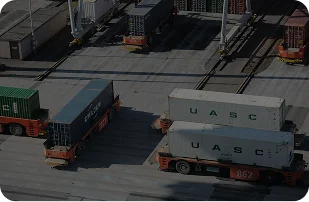Is Automated Fulfillment Right for Your Growing E-commerce Brand?

Quick answer: Automated fulfillment is indeed the right choice for many growing e-commerce brands.
As your order volume increases, the limitations of manual picking, packing, and shipping become increasingly difficult to manage. Automated fulfillment systems address these common obstacles by transforming time-consuming tasks into efficient operations that scale with your business growth.
Learn more about why automated fulfillment is good for most brands and can be right for your business.
Benefits of Automated Fulfillment for E-commerce Brands
Adopting automation in your fulfillment process creates numerous advantages that directly impact your bottom line and customer satisfaction.
Optimized Operations and Efficiency
Automated fulfillment systems transform manual processes by integrating technology at every step. These systems use barcode scanning, conveyor systems, and robotic picking to move products through your warehouse with minimal human intervention. This technological integration markedly reduces picking errors while accelerating the entire fulfillment process.
The time-saving aspect of automation is substantial. What once took hours of manual labor can be accomplished in minutes. Automated sorting systems can process hundreds of orders simultaneously, while automated packaging machines can prepare shipments at rates that manual teams simply cannot match.
Many businesses working with fulfillment centers report processing times dropping from days to hours after adopting automation. This efficiency translates directly to faster customer delivery times and higher throughput capacity during peak seasons.
Improved Customer Experience
Automated order fulfillment directly boosts customer satisfaction by addressing the two factors customers care about most: speed and accuracy. When orders are processed faster and with fewer errors, customers receive exactly what they ordered, when they expect it.
Businesses adopting fulfillment automation typically experience notable reductions in delivery times while maintaining exceptional order accuracy. This performance level creates trust and encourages repeat purchases, ultimately increasing customer lifetime value.
Many beverage companies have seen marked improvements in customer satisfaction after transitioning to automated fulfillment systems that enable consistent next-day delivery options. As noted in our guide on drinks logistics, this industry particularly benefits from automation due to fragile products and weight considerations.
Cost Savings and Scalable Solutions
While the upfront investment in automated fulfillment technology may seem substantial, the long-term cost savings are compelling. Labor costs typically represent a major portion of fulfillment expenses, and automation can substantially reduce these costs while simultaneously increasing output.
Inventory management becomes more precise with automation. Real-time tracking reduces stock discrepancies, preventing both costly overstocking and revenue-damaging stockouts. Warehouse space utilization improves through vertical storage systems and optimized picking routes, allowing you to maximize your existing facility footprint.
Most importantly, automated systems grow seamlessly with your business. Unlike manual processes where doubling order volume might require doubling staff, automated fulfillment systems can handle substantial increases in volume with minimal additional investment. This scalability proves particularly valuable for seasonal businesses or those in rapid growth phases.
Who Can Benefit from Automated Fulfillment?
Not every business needs to implement automated fulfillment systems immediately. Our experience shows specific types of operations gain the greatest advantages.
Fast-growing e-commerce brands often reach a tipping point where manual processes cannot keep pace with increasing order volumes. These businesses frequently struggle with hiring and training enough staff during growth phases, leading to fulfillment bottlenecks. Automated fulfillment systems allow these brands to scale operations smoothly without proportional increases in labor costs.
Companies handling high order volumes in health and beauty, beverage, or lightweight consumer goods face unique fulfillment requirements. When processing numerous orders daily, even small inefficiencies or error rates become magnified.
This is particularly true for recurring shipment models, where subscription box fulfillment requires exceptional consistency month after month. Automated order fulfillment systems excel in these environments, maintaining consistency and accuracy regardless of volume fluctuations. As discussed in our guide about critical strategies for Black Friday, automation helps businesses manage seasonal spikes without service disruptions.
Retailers focusing on operational excellence to improve margins benefit substantially from automated systems. By reducing labor costs and minimizing errors that lead to returns and customer service issues, automated fulfillment directly impacts profitability. Businesses with complex inventory management needs find that automated systems provide precision impossible with manual methods.
The table below helps determine if your business aligns with automation needs:
| Business Characteristic | Automation Readiness |
| Monthly order volume exceeds 300 | High |
| Experiencing rapid growth | High |
| Struggling with order accuracy | High |
| Managing diverse product lines | High |
| Facing seasonal volume variations | High |
| Operating with thin profit margins | High |
| Just starting out | Consider 3PL partnership |
| Limited capital for investment | Consider 3PL partnership |
Implementing Automated Fulfillment in Your Business
The transition to automated fulfillment requires careful planning and execution to maximize success.
Evaluate Current Fulfillment Operations
Before adopting automation, conduct a thorough assessment of your current fulfillment processes to identify pain points and opportunities for improvement. Start by mapping the complete order fulfillment journey from the moment an order is placed until it reaches the customer.
Track key performance indicators such as order processing time, picking accuracy, packing efficiency, and shipping timeframes. Identify which stages consume the most resources or create bottlenecks in your operation. Pay special attention to error-prone processes that affect customer satisfaction.
Document your current technology stack, including e-commerce platforms, inventory management systems, and shipping software. Understanding these elements helps determine what automation solutions will integrate most effectively with your existing infrastructure. This evaluation creates a baseline against which you can measure improvements after adopting automated systems.
Selecting the Right Fulfillment Software
Choosing appropriate fulfillment software forms the backbone of your automation strategy. Look for systems offering comprehensive features that address your specific business needs while providing room for growth.
The most effective fulfillment software solutions provide real-time inventory visibility across all sales channels and warehouse locations. This visibility prevents overselling and allows for proactive inventory management. Order synchronization capabilities confirm that orders from multiple platforms (your website, marketplaces, brick-and-mortar locations) flow seamlessly into a unified system.
Integration capabilities should be a primary consideration. Your fulfillment software needs to connect with your e-commerce platform, shopping cart, marketplace listings, shipping carriers, and accounting systems. For online retailers using popular CMS platforms, finding 3PL for WordPress solutions that integrate seamlessly is essential for growth. As outlined in our guide on omnichannel fulfillment, these integrations create a cohesive ecosystem that minimizes manual data entry and reduces errors.
Connecting with Your E-commerce Platform
The connection between your e-commerce platform and fulfillment system determines how smoothly orders flow through your operation. Seamless integration eliminates the need for manual order entry and reduces the delay between when customers place orders and when fulfillment begins.
Most modern e-commerce platforms offer API connections that allow for direct communication with fulfillment systems. These connections enable automatic transmission of order details, customer information, and shipping preferences directly to your fulfillment software. They also facilitate the return of tracking information and delivery updates to your e-commerce platform, where customers can check their order status.
When evaluating integration options, consider how quickly data syncs between systems. Near-real-time synchronization prevents delays in order processing and inventory updates that could lead to fulfillment errors. Also assess how the integration handles exceptions, as robust error handling prevents orders from getting lost between systems.
Advanced Strategies for Fulfillment Optimization
Once you’ve implemented basic automation, consider these advanced strategies to further refine your fulfillment operations.
Leveraging Predictive Analytics and Automation Tools
Predictive analytics transforms automated fulfillment from reactive to proactive by anticipating customer behavior and market trends. These tools analyze historical sales data, seasonal patterns, and external factors to forecast demand with remarkable accuracy.
By incorporating predictive analytics in your automated fulfillment system, you can optimize inventory levels across warehouse locations, reducing both stockouts and excess inventory costs. This approach allows you to position inventory strategically based on anticipated regional demand, cutting shipping costs and delivery times.
Advanced warehouse automation tools like automated storage and retrieval systems take fulfillment efficiency to another level. These systems use robots and conveyor systems to retrieve products from dense storage arrangements, maximizing space utilization while minimizing picker travel time. For businesses with space constraints or high SKU counts, these systems can dramatically increase throughput within existing facilities.
Optimizing Returns Management
Returns management often remains a manual process even in otherwise automated operations, creating a bottleneck and potential customer satisfaction issue. Incorporating automated returns management closes this loop in your fulfillment operation.
Automated returns systems begin with customer-friendly return portals integrated with your e-commerce platform. Customers can initiate returns, print shipping labels, and receive status updates without contacting customer service. Behind the scenes, these systems generate return merchandise authorizations automatically and alert warehouse staff about incoming returns.
When returns arrive at your facility, barcode scanning automatically updates inventory levels and triggers appropriate actions—whether restocking, inspection, refurbishment, or disposal. The system can also automate refund processing based on predefined rules, eliminating delays that frustrate customers. As highlighted in our guide on order fulfillment mistakes, efficient returns processing is critical for maintaining customer loyalty.
Automated Fulfillment FAQs
What does automated fulfillment mean?
Automated fulfillment refers to using technology, such as robotics and software, to process orders, pick and pack items, and manage inventory. Automation reduces manual labor, increases speed, and improves accuracy in fulfillment centers.
What are examples of automated processes?
Examples of automated processes include order fulfillment, inventory management, chatbots for customer support, and automated invoicing. Businesses use robotic picking systems, barcode scanning, and AI-driven analytics to streamline operations.
What is the difference between fulfillment and logistics?
The main difference between fulfillment and logistics is that fulfillment focuses on processing and shipping customer orders, while logistics manages transportation, warehousing, and supply chain operations. Fulfillment is a subset of logistics, ensuring order completion.
What is order fulfillment KPI?
Order fulfillment KPIs measure efficiency in processing and delivering orders. Key metrics include order accuracy rate, fulfillment cycle time, inventory turnover, and on-time delivery rate. These KPIs help optimize supply chain performance.
How do automated warehouses work?
Automated warehouses use robotics, AI, and conveyor systems to manage inventory, pick and pack orders, and streamline shipping. Technologies like automated storage and retrieval systems (AS/RS) improve speed and accuracy while reducing labor costs.
Take Your E-commerce Growth to the Next Level with Automated Fulfillment
Automated fulfillment represents a significant competitive advantage for growing e-commerce brands facing increasing order volumes and customer expectations. By optimizing operations, boosting accuracy, and scaling efficiently with your business growth, these systems directly impact both customer satisfaction and your bottom line.
Whether you choose to implement automation in-house or partner with a 3PL provider offering automated fulfillment services, the key is taking a strategic approach.
At Innovative Warehouse Solutions, we specialize in helping growing e-commerce brands implement transparent, customer-focused automated fulfillment strategies tailored to your unique needs. Our clear pricing and personalized approach guarantee you get exactly the level of automation your business requires without unnecessary complexity or hidden costs.
Contact us today to learn how we can handle your fulfillment complexity, allowing you to focus on creating more orders and growing your brand.




